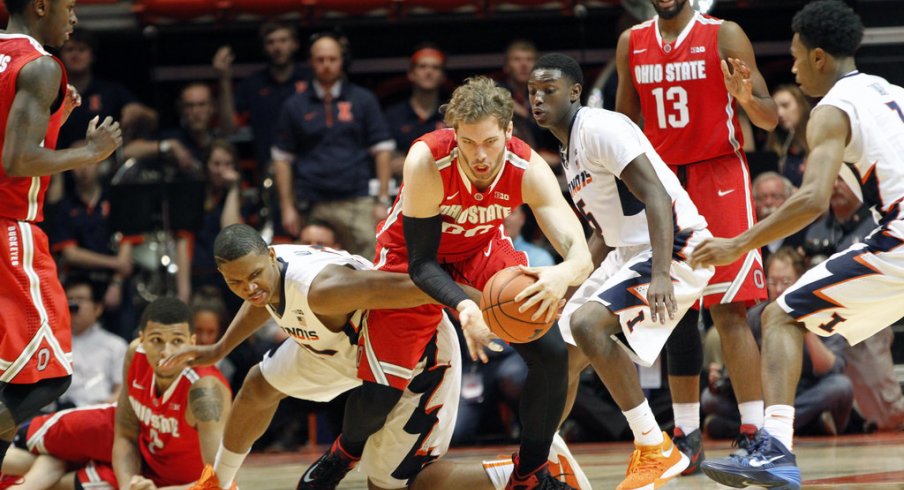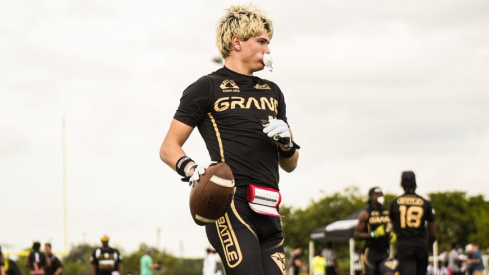End of game situations are difficult to define by any statistical measure. The leading hot-takers of our time will call players who perform well in these scenarios "clutch." If that isn't the case, they lack a "clutch gene."
Performing well under the pressure of a close game isn't necessarily tangible and it's simply magnified in our minds because of the score and time remaining. However, there is something to be said for being mentally prepared to the handle late-game situations and executing when the clock winds down.
Illinois and Maryland were one-possession games with under a minute left in the second half, let's see how a young Ohio State team fared.
Like the Purdue game a week prior, the Buckeyes found themselves in a close conference game on the road.
"That was our whole deal in practice this week just to make sure we come out and compete," Jae'Sean Tate said, following the loss to the Boilermakers. "We’ve just got to learn how to continue to do that and play smarter at the end of the games when possessions are important."
Tate's team showed occasional progress in that respect against Illinois. The Illini attacked A.J. Harris and Keita Bates-Diop a few times via the pick-and-roll. Although there was some confusion between the two in their coverage, help defense allowed them to recover.
Although Illinois' spacing wasn't ideal, Tate wisely left his man to run Kendrick Nunn off the three-point line – only necessary because Harris and Bates-Diop followed the ball-handler. When Nunn attacked the basket, Tate forced him baseline and Trevor Thompson prevented him from getting a layup:
The Buckeyes did not score in the final three minutes of regulation and only scored twice in the last 6:30 of the second half. Defense was generally solid, but the lack of scoring made it difficult to even force overtime – this, after leading by 13 late in the half.
Too many times, Illinois shut down Ohio State's initial offensive action and the Buckeyes didn't know what to do. They reverted to isolation ball, bringing it out to midcourt and draining the clock, even immediately after a timeout:
Something clicked in overtime. Matta or someone on his staff suggested moving JaQuan Lyle off ball more.
Rather than trying to create one-on-one or with a high screen, as he typically does, Lyle had more space after this dribble hand-off and immediate screen from Thompson – it allowed him to attack quickly and find Bates-Diop, who floated towards his typical corner three spot, but came back to the ball:
Naturally, I have to discuss the game's final play. Ted Valentine receives heavy criticism from fans, writers and broadcasters for seemingly making himself a part of the game. He is confrontational with coaches, overly emphatic with his calls and interacts with fans in the middle of a game.
While we're all focused on his antics, we must not forget to criticize him for poor officiating. Like this, although we can also applaud Ohio State for not giving up a three-point attempt up three:
A couple of defensive lapses down the stretch against Maryland prevented the Ohio State from winning outright or forcing overtime.
In what would be his only field goal of the game, Rasheed Sulaimon hit this three to make it a two-possession game. There appeared to be a miscommunication on a baseline screen by Jake Layman to free Sulaimon. Marc Loving unknowingly backed into the screen, and Bates-Diop could've switched with Loving to possibly prevent the pass from even getting to Sulaimon:
It was still a one-possession game later in the half, but this Melo Trimble three nearly put the game out of reach. Trimble never left the corner; his defender left him.
After several well-executed dribble hand-offs, OSU seemed in good position to handle the pick-and-roll action. Trevor Thompson dropped below the free-throw line and extended his arms to prevent a lob pass to Damonte Dodd. Kam Williams even recovered in time to prevent Suliamon from pulling up from midrange.
If Bates-Diop stayed in the corner on Trimble, perhaps Suliamon would've attempted a difficult bounce-bass to Dodd around Thompson. Instead all he had to do was lob it to the open Trimble. He's struggled to consistently hit threes in conference play, but Trimble is a career 38-percent three-point shooter. He's certainly capable of knocking down an open shot from the short corner:
With an upcoming road game at Wisconsin, two matchups with Michigan State and one with No. 3 Iowa to close the season, late-game execution will have to be more consistent on both ends.


